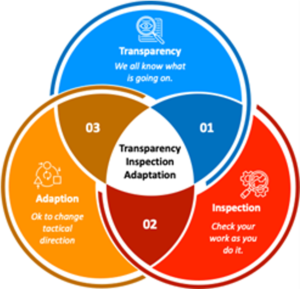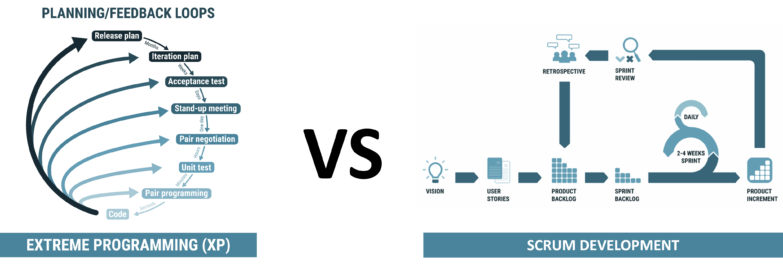Agile Development: Extreme Programming (XP) vs Scrum Development
As principal methodologies of Agile Software Development, many teams find themselves deciding between Extreme Programming (XP) vs Scrum Development at some point. While experienced teams may be able to easily tell the two apart with their eyes closed, for new users, these methodologies can be uncomfortably similar. In fact, you could be excused if you took one for the other.
As a result, deciding which of the two methodologies provides the most value on specific projects can be challenging. In this blog, our expert consultants are sharing insights on the core differences between Extreme Programming (XP) vs Scrum Development, when each should apply, and the prospects of a hybrid ScrumXP approach.
What is XP?
XP is a low-risk, lightweight, flexible method of developing software. XP builds on the core premise of Agile, which is to incrementally deliver high-quality products in a manner that is nimble enough to accommodate changing requirements.
Compared to the broader Agile framework, though, XP’s focus is strictly on software programming practices taken to the “extreme.” The methodology uses mostly traditional software engineering practices but employs them radically during intense creation periods.
practices taken to the “extreme.” The methodology uses mostly traditional software engineering practices but employs them radically during intense creation periods.
The goal of XP is to efficiently deliver top-quality software to the customer within the shortest time possible. The methodology makes this possible by focusing on small releases. Essentially, it takes the focus away from aiming to ship the entire product in one big delivery. Instead, it breaks the task down into rapidly-deliverable shipments that can be continuously tweaked and integrated into the whole product.
The major roles in XP are customer, programmer, and coach, with an emphasis on customer involvement. The customer leads the process by describing their software needs in the form of stories that guide actual development. Programmers estimate the stories, and the customer decides in what order programmers will develop the stories. The coach ensures that the project is on track and jumps in to help as needed.
The XP process has three main stages: release planning, iteration, and release. During release planning, all parties meet to determine stories and the order they will be developed. Iteration is where the programmers code software in line with the stories, typically over one to two weeks, and the customer develops tests to assess the developed solutions. Finally, the solution is installed at the release stage, and customer approval follows.
XP uses several practices, including the following: collective code ownership, pair programming, simple design, constant testing, continuous integration, refactoring, small releases, and code standards.
What situation does it best suit? XP works best with projects that have loose definitions or fast-changing requirements. It can be employed best by small to mid-size teams.
What is Scrum development?
Scrum is a project management practice with efficiency, organization and teamwork as its core focus. It is intended to direct a team’s creativity towards adaptively solving complex problems.
Like XP, Scrum breaks large problems down into doable chunks and then attacks them with high energy and creativity over short periods called sprints. However, unlike XP, Scrum isn’t peculiar to software development. Nevertheless, its principles and practices adapt very well to programming.
Scrum is based on three primary pillars: transparency, inspection, and adaptation. These principles mean that the work done in the team should be open to all to encourage collective ownership; work should be checked thoroughly, frequently, and objectively; and teams should bake flexibility into their process.
be open to all to encourage collective ownership; work should be checked thoroughly, frequently, and objectively; and teams should bake flexibility into their process.
In Scrum, there are also three main players: the product owner, Scrum master, and development team. The product owner is essentially the customer – they own the work order. The Scrum master actively manages the development team and leads delivery in increments of value through sprints. The development team produces the content (or something).
The Scrum process involves an initial planning meeting where the parties define the project goals and discuss how to achieve these goals. The sprint comes after and may take between two weeks to a month. Next up is a review meeting where the team presents their work. At the final stage, the retrospective, the team assesses their progress, takes feedback from the client, and sets action points for the next sprint.
Overall, Scrum is a highly adaptable methodology that works well at the project management level. It can be used by small to large teams and is an effective framework to achieve quality products in a fluent, flexible, and repeatable manner.
Extreme Programming (XP) vs Scrum Development: How do you choose between the two?
XP and Scrum have many overlapping features. For example, they emphasize adaptable, iterative development over short periods and are designed to deliver value frequently in an efficient and repeatable manner.
There are differences between the two methodologies, though. First, Scrum has a wider application than XP since it is not restricted to software development. Teams can apply it to the development and shipment of various products due to its focus on management.
Scrum emphasizes productivity and value. Unlike XP, it does not dictate specific engineering techniques that programmers must follow. XP not only specifies what practices should be implemented, leaving out any one of the twelve identified practices might affect the whole project.
While both Scrum and XP aim to ship product iterations within short, repeatable periods, the relative lengths are different. Scrum sprints typically last two to four weeks, while XP delivers iterations within one to two weeks.
Scrum is relatively more rigid in application than XP. In Scrum, changes cannot be added after the sprint planning meeting. Nothing can change during the sprint once the features and project scope are decided during the meeting. Any nominated changes by the product owner or team internally must wait until after the sprint. Comparably, XP provides more flexibility since it allows new items and changes, even mid-sprint. In addition, you can replace items within a sprint if they have not started at the time of the change.
XP can also be rigid when it comes to following prioritized customer stories. Once the customer decides how tasks should progress, the team must follow that order. Scrum has no such rigidity, though. Instead, developers may determine how they want to approach tasks so long as they complete them by sprint end.
Ultimately, the decision between Extreme Programming (XP) vs Scrum Development comes down to the peculiar requirements of the project and how the team would prefer to work. Once you identify the practices of each methodology, decide which one you’re most comfortable with and proceed accordingly.
Hybrid models – when do they apply, and how to create one?
Many teams face projects that they believe will benefit from aspects of both methodologies. You can implement a hybrid approach that implements Scrum at the project management level while XP principles come to the fore during actual software development. However, clarify what methodology you are applying, and at what stage so there’s no confusion amongst your team members.
Also, it’s essential to master the basic principles of each ideology before you start the merge. Know what principles and practices are mandatory, so you’re not misled during your implementation journey.
i3solutions will simplify and accelerate the process
i3solutions has over 25 years’ experience advising on and leading deployments of all sizes and complexity using these proven Agile methodologies. Contact us today and let our Agile development team advise your organization on how the best practices of Extreme Programming (XP) vs Scrum Development can be used to solve the business challenges you are facing.
Leave a Comment


